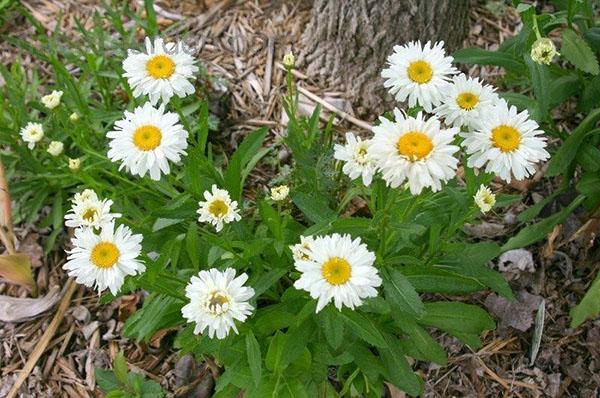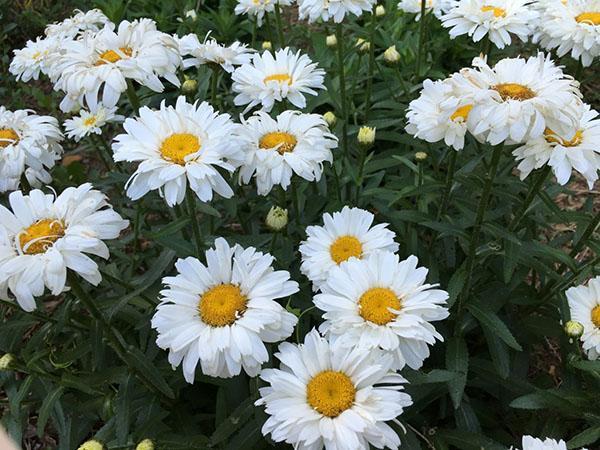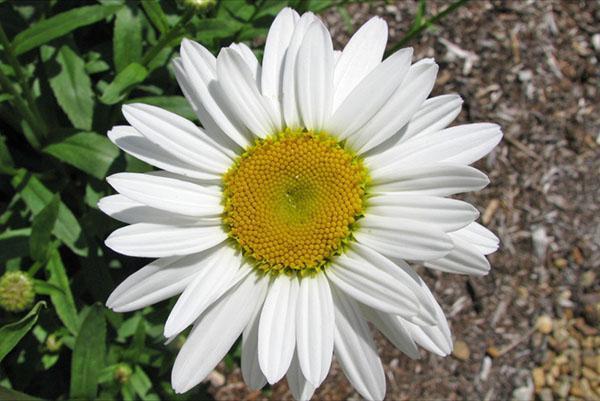Snow-white garden chamomile can decorate any area
 Chamomile blooming in the meadow and in the garden leaves no one indifferent. Garden chamomile is a favorite flower of Russian summer residents. Several dozen species of herbaceous perennials in nature can be found in all climatic zones, except for the tropics, ice and deserts.
Chamomile blooming in the meadow and in the garden leaves no one indifferent. Garden chamomile is a favorite flower of Russian summer residents. Several dozen species of herbaceous perennials in nature can be found in all climatic zones, except for the tropics, ice and deserts.
The culture attracts flower growers with massive and long flowering, easy care and the ability to plant and propagate the variety they like without much experience. Read about planting a perennial primrose and caring for it with a photo.
Description of garden perennial chamomile

Today, thanks to the efforts of breeders, semi- and terry varieties of garden chamomile have come to the disposal of gardeners.
In comparison with wild specimens in cultivated perennials:
- the flowers are larger;
- bud formation is much more active;
- the flowering period is longer;
- re-emergence of flowers is possible in the second half of summer.
 The garden chamomile, Leucanthemum vulgare or Leucanthemum maximum, depicted in the photo, is most often called by the people a daisy or a clerk. In early spring, a rosette of oblong basal leaves appears above the soil. When inflorescences appear on faceted erect stems, the plant height can vary from 20 to 80 cm.Depending on the variety, the diameter of the inflorescences can reach from 3 to 10 cm.
The garden chamomile, Leucanthemum vulgare or Leucanthemum maximum, depicted in the photo, is most often called by the people a daisy or a clerk. In early spring, a rosette of oblong basal leaves appears above the soil. When inflorescences appear on faceted erect stems, the plant height can vary from 20 to 80 cm.Depending on the variety, the diameter of the inflorescences can reach from 3 to 10 cm.
Reproduction of garden chamomile by dividing the bush
 Chamomile planted on the site grow well, form curtains, which, even outside flowering, retain their decorative effect and resemble green pillows. However, after a few years perennial rejuvenation is required, otherwise the inflorescences become smaller every year, the foliage becomes smaller and weaker.
Chamomile planted on the site grow well, form curtains, which, even outside flowering, retain their decorative effect and resemble green pillows. However, after a few years perennial rejuvenation is required, otherwise the inflorescences become smaller every year, the foliage becomes smaller and weaker.
Perennial garden daisies reproduce by seed and vegetative means. If these beautiful flowers are already growing on the flower beds, it is enough to divide the adult curtain into several.
It is best to plant a perennial in the first half of autumn, dividing the plant into parts so that each has a part of a strong rhizome and several points of growth. The soil for planting chamomile should be dug, weed-free and moistened:
- The hole is dug a little more than the root system.
- The plant in the planting pit is placed at the same level, after having straightened the rhizomes.
- The hole is covered with soil, which is compacted and watered.
 Since the seeds from the faded baskets do not transfer the features of the parent plants, vegetative propagation is indispensable if you want to get young clumps of any varietal garden chamomile.
Since the seeds from the faded baskets do not transfer the features of the parent plants, vegetative propagation is indispensable if you want to get young clumps of any varietal garden chamomile.
The more often the curtains are rejuvenated, the more spectacular their flowering and the larger the inflorescences. However, a spring transplant can delay or cancel the appearance of buds.
Read about:Gaillardia perennial planting and care with a photo
Sowing perennial garden chamomile and planting it in the ground
Chamomile seeds have excellent winter hardiness, so they can be sown both in spring and before winter. Sowing in autumn will not only save precious spring time, but also provide natural stratification. This means that the seedlings will be more friendly and strong.
 Spring reproduction of garden chamomile by seeds is possible in two ways:
Spring reproduction of garden chamomile by seeds is possible in two ways:
- sowing in thawed, dug up and loosened open ground;
- sowing at home for seedlings, which are transferred to a flower bed in the warm season.
In the second case, the plants are stronger, they bloom earlier and manage to form a lush, strong rosette by winter. Planting garden chamomile seedlings is carried out in the second half of February or in March. For sowing, take a light loose substrate based on sand, garden soil and peat... Seeds in several pieces are laid out in seedling containers or peat pots filled with moistened soil. Sprinkle on top with a thin layer of the same substrate.
 Crops should be kept under film or glass and at high humidity until sprouting, that is, 10-15 days. Then the trays are transferred to the light and the shelter is removed. If necessary, arrange additional illumination for 14 hours a day, otherwise the seedlings are strongly stretched and weakened.
Crops should be kept under film or glass and at high humidity until sprouting, that is, 10-15 days. Then the trays are transferred to the light and the shelter is removed. If necessary, arrange additional illumination for 14 hours a day, otherwise the seedlings are strongly stretched and weakened.
A pick is carried out when the seedling of garden chamomile will open 2-4 true leaves and will be about 5 cm high. For active tillering, the main stem can be pinched.
One and a half or two months after sowing, young plants are taken out into open ground in previously prepared sunny areas without stagnant water and with neutral soil acidity.
The planting of garden daisies is carried out in prepared soil, which is not only dug up, but also loosened. Weeds are carefully selected from the soil, and complex fertilizer for ornamental flower crops is applied to feed the seedlings.
It is more convenient to transfer seedlings with a clod of earth without damaging the root system. In this case, the holes are dug slightly larger than the size of the containers, and the gaps are carefully covered with soil, compacted and watered. Although the plants are still small, they have to grow strongly, therefore, gaps of 20 to 40 cm are left between the seedlings, depending on the variety of garden chamomile and the design of the flower bed. The first flowering of plants planted with seeds and seedlings should be expected only after a year.
Caring for garden chamomile after planting
 All types of chamomile, including garden chamomile, are photophilous. They do not tolerate the proximity of groundwater and growing in dense, caking soil.
All types of chamomile, including garden chamomile, are photophilous. They do not tolerate the proximity of groundwater and growing in dense, caking soil.
But at the same time, perennials beloved by flower growers are very undemanding to care and can grow even on soils poor in humus, tolerate drought and not be afraid of serious attacks of pests.
However, after planting garden chamomile, caring for them should be careful and systematic. Young plants need frequent watering until rooting is complete. Flowers that have firmly settled in a new place are no longer so delicate, and they are watered only in hot, dry weather.
The time for watering is chosen so that drops of water in the sun do not play the role of lenses and do not cause ugly burns on the leaves and inflorescences.
To keep the moisture content of the soil longer, the root zone mulch peat. In addition, the flower bed is regularly weeded, and the surface layer of the earth is loosened.
Although garden daisies are very unassuming, they can only achieve lush blooms if the plants are fed enough. Therefore, nitrogen fertilizers are applied under the roots in spring. Wilted inflorescences must be cut off together on the stem. This will help keep the plant strong and adorn the area with white chamomile lace for a long time.
 When flowering ends, flower care does not stop. Closer to autumn, the division of adult clumps is carried out, all old, dead parts are removed, peduncles and dry leaves are cut out.
When flowering ends, flower care does not stop. Closer to autumn, the division of adult clumps is carried out, all old, dead parts are removed, peduncles and dry leaves are cut out.
If the soil in the area is acidic, in the fall it must be deoxidized with dolomite flour or lime.
Chamomiles are frost-hardy, however, in winters with little snow, they can freeze out, so the curtains are cut to the ground before cold weather and sprinkled with peat, spruce branches or other suitable material.